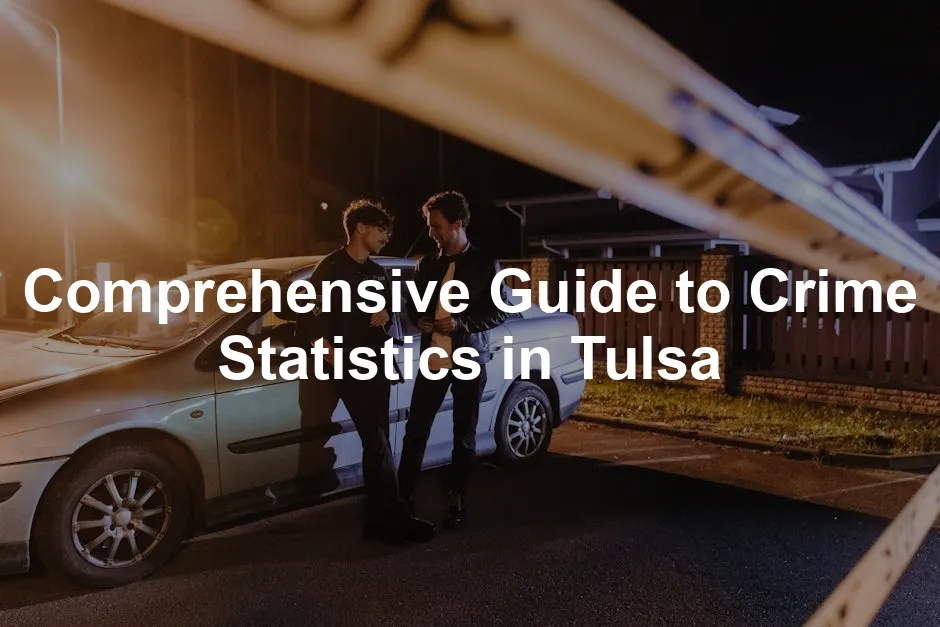Introduction
Understanding crime statistics in Tulsa is crucial for residents and potential movers. This article provides a detailed analysis of crime rates, trends, and comparisons in Tulsa, Oklahoma. By examining these statistics, we aim to empower readers with the information needed to make informed decisions about safety, community well-being, and real estate investments.
Crime rates play a significant role in community safety and real estate decisions. High crime rates can deter families from moving to certain areas, while lower rates may attract them. Knowledge of crime statistics allows individuals to assess the safety of neighborhoods and identify potential risks. This awareness also aids local law enforcement in addressing community concerns and improving safety measures.
Speaking of safety, how about adding a little extra peace of mind? Consider investing in a Personal Safety Alarm with LED Light. It’s a small device that can make a huge difference in feeling secure while out and about. Plus, it’s like having a superhero in your pocket—just pull the pin, and voila! Instant attention!
Our data comes from reliable sources including local law enforcement agencies, the FBI, and community feedback. These sources provide a comprehensive overview of Tulsa’s crime landscape, ensuring the information is accurate and up-to-date. With a blend of serious insights and light-hearted commentary, we will guide you through the intricacies of crime statistics in Tulsa, making it both informative and engaging.

Understanding Tulsa’s Crime Landscape
Overview of Crime Rates
Tulsa’s overall crime rate stands at a staggering 52 per 1,000 residents. This figure reveals that living in Tulsa may come with a higher risk of becoming a victim of crime compared to other cities. To put this into perspective, the chances of experiencing a violent crime in Tulsa are roughly 1 in 108, while property crime presents an even greater risk at 1 in 23. Talk about an alarming statistic!
When compared to national averages, Tulsa’s violent crime rate of 9.25 per 1,000 residents is notably higher. In contrast, the national median hovers around 4 per 1,000. Similarly, property crime in Tulsa is also significantly elevated, with a rate of 42.63 per 1,000 residents compared to the national median of 20.
These figures make one thing clear: Tulsa faces considerable challenges in maintaining safety for its residents. But fear not! Awareness is the first step toward improvement. By understanding the current crime landscape, residents can take proactive measures to enhance their safety and well-being.

If you’re looking to boost your home security, consider a Home Security Camera System. It’s like having an extra pair of eyes watching your property 24/7. Plus, you can keep an eye on things from your smartphone, ensuring you’re always in the loop, even when you’re not home!
In conclusion, crime statistics in Tulsa provide valuable insights into the city’s safety and security. With a comprehensive understanding of these rates, residents can take steps to safeguard their communities and make informed decisions about their living environments.
Violent vs. Property Crimes
When we talk about crime, there are two main categories: violent crimes and property crimes. Violent crimes involve the use or threat of force against individuals. This includes acts like murder, rape, robbery, and assault. Property crimes, on the other hand, focus on the unlawful taking or destruction of someone else’s belongings. Think burglaries, thefts, and vehicle thefts.
Now, let’s break down the numbers.
Breakdown of Violent Crimes
Tulsa reported a total of 3,810 violent crimes in the last year. Here’s how they stack up:
- Murder: 57 incidents, which translates to about 0.14 per 1,000 residents. A small number, but every life lost is significant.
- Rape: 369 incidents, equating to 0.90 per 1,000 residents. This statistic highlights a serious issue that needs addressing.
- Robbery: 470 incidents, representing a rate of 1.14 per 1,000 residents. Robbery remains a concern for many local residents.
- Assault: A staggering 2,914 incidents, which brings the rate to 7.08 per 1,000 residents. This is where the numbers really start to paint a worrying picture.

For those who enjoy a good mystery, consider reading Crime and Punishment by Fyodor Dostoevsky. It’s a classic exploration of morality and the human psyche, perfect for contemplating the darker aspects of life while cozying up with a cup of coffee.
Breakdown of Property Crimes
Switching gears to property crimes, Tulsa reported a whopping 17,558 incidents. Here’s the breakdown:
- Burglary: 3,591 incidents, or about 8.72 per 1,000 residents. This statistic shows that many folks are at risk of having their homes invaded.
- Larceny: A staggering 10,827 incidents, which means 26.29 per 1,000 residents. Theft is rampant, and it can happen anywhere, anytime.
- Motor Vehicle Theft: 3,140 incidents, or 7.62 per 1,000 residents. Car thefts are a common headache for residents who rely on their vehicles.

If you want to keep your vehicle safe, consider a GPS Tracker for Vehicles. This nifty device allows you to keep tabs on your car’s location, giving you that extra layer of security and peace of mind.
In summary, the crime statistics in Tulsa reveal a mixed bag. While violent crimes like murder and rape draw attention, property crimes are alarmingly high. Understanding these numbers is crucial for residents and those considering moving to the area. Armed with this knowledge, individuals can take proactive steps to increase their safety and security.
Crime Rate Comparison
Tulsa vs. National Averages
Tulsa’s crime rates are a real eye-opener. With a violent crime rate of 9.25 per 1,000 residents, the city surpasses the national median of 4 per 1,000. When it comes to property crime, Tulsa’s rate stands at a staggering 42.63 per 1,000, compared to the national average of 20. This places Tulsa among the top 100 most dangerous cities in the United States.
Let’s break it down further. The chance of falling victim to a violent crime in Tulsa is 1 in 108. For property crime, this risk skyrockets to 1 in 23. If you’re thinking that sounds a bit daunting, you’re not alone! Many residents share these concerns, especially those considering relocating to the area.

Discussion on Implications
So, what does all this mean for current residents and potential newcomers? First off, it’s critical for residents to stay informed and vigilant. Understanding these statistics can help individuals take proactive measures to enhance their safety. Neighborhood watch programs, community engagement, and safety workshops are great ways to foster a safer environment.
For newcomers, these statistics might raise a few eyebrows. They highlight the importance of researching specific neighborhoods before making the move. Some areas in Tulsa are significantly safer than others. Informed decisions based on crime statistics can lead to better living choices and peace of mind.
Moreover, these crime statistics can impact local real estate. Higher crime rates may deter home buyers, causing property values to stagnate or decline. On the flip side, neighborhoods showing improvement in safety may see a rise in demand and property prices.
In essence, while Tulsa’s crime rates pose challenges, awareness and community efforts can pave the way for a safer future. It’s all about finding that balance between enjoying city life and being proactive about safety.
Public Perception and Community Response
Community Sentiment
Surveys reveal a mixed bag regarding safety in Tulsa. A recent community poll showed that about 55% of respondents feel generally safe in their neighborhoods. However, the remaining 45% expressed concerns about crime, indicating a significant divide in community sentiment.
When it comes to perceptions of law enforcement, opinions vary. Approximately one-third of respondents believe police are highly visible and responsive. Yet, 26% feel that while police are present, they respond slowly when needed. This suggests a disconnect between community expectations and police effectiveness.

Residents often share anecdotal experiences of feeling uneasy, particularly in certain parts of the city. A number of online discussions highlight frustrations with response times and the effectiveness of local law enforcement, creating a need for improvement in community-police relations.
Community Initiatives and Law Enforcement Efforts
Despite the challenges, Tulsa boasts several initiatives aimed at improving safety. Community programs focus on reducing crime and fostering engagement between residents and law enforcement. For instance, the Tulsa Police Department launched the “National Coffee with a Cop Day,” where officers meet residents in casual settings to discuss concerns and build trust.
Additionally, cleanup events, like the “Clean Up Day” at McCullough Park, encourage community pride and collaboration. Such initiatives not only beautify neighborhoods but also create a sense of collective responsibility for safety.
The Tulsa Police Department is also proactive in mental health outreach. Partnering with the Mental Health Association Oklahoma, they provide assistance to citizens experiencing crises. This approach recognizes that many issues contributing to crime stem from broader social challenges.
Overall, community engagement and police initiatives are crucial in addressing crime. By fostering relationships and promoting safety programs, both residents and law enforcement can work together to create a safer Tulsa. The road ahead may be long, but progress is being made, one cup of coffee and cleanup at a time.

Trends and Future Outlook
Year-over-Year Trends
Analyzing crime rates over the past few years reveals notable trends. While Tulsa faces high crime rates, there has been a slight decline in overall crime. Recent statistics indicate that violent crime decreased by approximately 14.8% this past year, suggesting that efforts to improve community safety are beginning to bear fruit.
However, property crime remains a significant concern. The property crime rate has also seen a decrease of about 12.9%. Economic factors, such as employment rates and community programs, likely play a role in these trends. With unemployment hovering around 4.1%, slightly below the national average, it seems that economic stability contributes to the drop in crime rates.

Future Predictions
Outlook on Crime Rates
Tulsa’s crime rates are a hot topic. As we look ahead, it’s essential to consider the potential trends. Historical data suggests a slight decline in both violent and property crimes. This shift could continue if community programs gain traction. Local initiatives and police efforts might help bring these numbers down further. But, it’s not all rainbows and butterflies. The economic landscape plays a significant role. If job opportunities increase, crime rates could decrease. However, if the economy falters, crime might rise again.

Importance of Ongoing Engagement
Engagement from the community is vital. It’s not just about calling the police when something goes wrong. Residents need to be proactive. Programs that foster communication between law enforcement and citizens can lead to better safety outcomes. Initiatives like “Coffee with a Cop” allow for casual conversations. They help build trust and understanding.
Moreover, active involvement in community events enhances neighborhood ties. When people know their neighbors, they’re more likely to watch out for one another. This creates a ripple effect, leading to safer neighborhoods. Schools and local organizations can collaborate to address safety concerns. Engaging youth in positive activities discourages them from falling into crime.
In short, ongoing community engagement is key to reducing crime in Tulsa. As residents come together, they create a supportive environment that discourages criminal activity. The future holds promise, but it requires effort from everyone.
Conclusion
Understanding Tulsa’s crime statistics is more than just crunching numbers. It’s about recognizing trends, implications, and the power of community. This article has highlighted key findings that can help residents and newcomers alike.
First and foremost, it’s clear that Tulsa faces significant challenges. The overall crime rate is alarmingly high. With a violent crime rate of 9.25 per 1,000 residents, it surpasses the national median. Property crime is even more concerning, standing at 42.63 per 1,000. The odds of becoming a victim are not just statistics; they impact lives daily. However, there’s hope. Recent trends show a slight decline in crime rates, thanks to community efforts and increased awareness.
Engagement is crucial. Community programs and initiatives have the power to transform neighborhoods. By fostering relationships between law enforcement and residents, trust builds. This trust is essential for effective crime prevention. The importance of knowing your neighbors cannot be overstated. When residents unite, they create a safer environment for everyone.
As we move forward, staying informed is vital. Crime statistics are not static; they evolve. Keeping an eye on local trends can help residents make informed choices about their safety. Engaging in community safety initiatives is another way to contribute. Whether it’s joining a neighborhood watch or participating in local events, every little bit counts.

Speaking of safety, don’t forget about the essentials. A First Aid Kit for Home and Travel is a must-have! You never know when you might need it, and being prepared is half the battle!
In conclusion, understanding crime statistics in Tulsa empowers residents. It encourages proactive measures to enhance safety. As we look ahead, let’s work together to create a safer community for all.
FAQs
What is the current crime rate in Tulsa?
The crime rate in Tulsa is 52 per 1,000 residents. This includes both violent and property crimes. Specifically, the violent crime rate is 9.25 per 1,000 residents, while property crime sits at 42.63 per 1,000 residents.
How does Tulsa’s crime rate compare to other cities in Oklahoma?
Tulsa’s crime rate is significantly higher than most cities in Oklahoma. For instance, cities like Bixby and Jenks have much lower crime rates, making them safer options for residents.
What neighborhoods are considered the safest in Tulsa?
Neighborhoods such as Hampton Oaks, Delaware Pointe, and Preston Woods are known for their lower crime rates. These areas often have community programs in place to enhance safety.
What can residents do to help reduce crime?
Residents can engage in community safety initiatives, join neighborhood watch programs, and participate in local events. Building relationships with neighbors and local law enforcement can foster a safer environment.
And while you’re at it, why not enjoy your leisure time with a Board Game for Family Game Night? It’s a perfect way to bond with family while having a blast—because who doesn’t love a little friendly competition?
Please let us know what you think about our content by leaving a comment down below!
Thank you for reading till here 🙂
All images from Pexels




